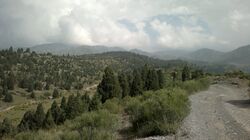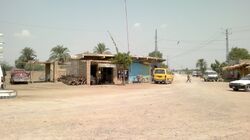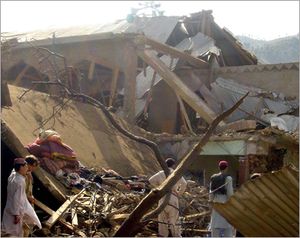شمال وزيرستان
North Waziristan District
ضلع شمالی وزیرستان شمالي وزیرستان ولسوالۍ | |
|---|---|
Top: Shawal Valley Bottom: street in Mir Ali | |
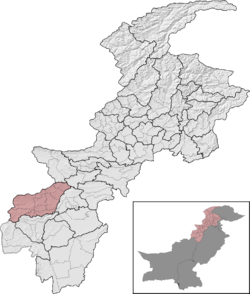 North Waziristan District (red) in Khyber Pakhtunkhwa | |
| الإحداثيات: 32°58′54″N 70°08′00″E / 32.98161274532541°N 70.13333546791706°E | |
| Country | |
| Province | |
| Division | Bannu |
| Established | 1910 (as an agency of Federally Administered Tribal Areas) |
| Headquarters | Miranshah |
| Number of Tehsils | 9 |
| الحكومة | |
| • النوع | District Administration |
| • Mayor | N/A |
| • Deputy Commissioner | Manzoor Ahmed Afridi |
| • District Police Officer | Farhan Khan (BPS-18 PSP) |
| المساحة | |
| • الإجمالي | 4٬707 كم² (1٬817 ميل²) |
| التعداد (2017)[2] | |
| • الإجمالي | 540٬546 |
| • الكثافة | 110/km2 (300/sq mi) |
| منطقة التوقيت | UTC+5 (PST) |
| Main language | Pashto |
| الموقع الإلكتروني | northwaziristan |
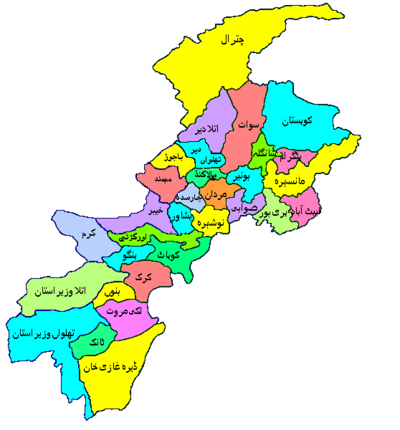
ضلع شمال وزيرستان (Pashto: شمالي وزیرستان ولسوالۍ, أردو: ضلع شمالی وزیرستان)، هي منطقة جبلية في شمال غرب پاكستان.[3][4][5] وهي الجزء الشمالي من وزيرستان، المنطقة الجبلية في شمال غرب باكستان، وتحد أفغانستان وتحدها أفغانستان وتغطي مساحة 585.11 كم².[6] عاصمة شمال وزيرستان هي ميران شاه. وتضم المنطقة الواقعة غرب وجنوب غرب بيشاور ما بين نهر توشي إلى الشمال من نهر جومال في الجنوب، مكونة أحد المناطق القبلية في الباكستان.
. . . . . . . . . . . . . . . . . . . . . . . . . . . . . . . . . . . . . . . . . . . . . . . . . . . . . . . . . . . . . . . . . . . . . . . . . . . . . . . . . . . . . . . . . . . . . . . . . . . . . . . . . . . . . . . . . . . . . . . . . . . . . . . . . . . . . . . . . . . . . . . . . . . . . . . . . . . . . . . . . . . . . . . .
التاريخ
North Waziristan comprises the area west and south-west of Khyber Pakhtunkhwa between the Kurram River (Tochi) to the north and the Gomal River to the south. Miramshah is district headquarter of North Waziristan. The city of Bannu lies immediately to the east, while the largest town on the Afghan side of the border is Khost.
North Waziristan is divided into the three subdivisions of Mirali, Miran Shah, and Razmak. The three subdivisions are further divided into nine tehsils: Datta Khel Tehsil, Dossali Tehsil, Gharyum Tehsil, Ghulam Khan Tehsil, Mir Ali Tehsil, Miran Shah Tehsil, Razmak Tehsil, Shewa Tehsil, Spinwam Tehsil.[7]
British (1894–1947)
The British entered Waziristan in 1894. After the British military operations in 1894–95, Waziristan was divided into two "agencies", North Waziristan and South Waziristan. The two parts have quite distinct characteristics, though both tribes are subgroups of the Wazir tribe, after which the region is named,[8] and speak a common Waziristani dialect. They have a famed reputation as formidable warriors, and are known for their hospitality. The tribes are divided into sub-tribes governed by male village elders who meet in a tribal jirga. Socially and religiously, Waziristan is an extremely conservative area. Women are carefully guarded, and every household must be headed by a male figure. Tribal cohesiveness is strong because of "Collective Responsibility Acts" in the Frontier Crimes Regulation.
In 1910, North Waziristan Agency was constituted as a full-fledged agency with its headquarters at Miramshah. It is inhabited by the Wazir and Dawar tribes. The agency lies from 32.35 degrees to 33.22 degrees north latitude and 69.22 degrees to 70.38 degrees east longitude. It is bounded on the north by Afghanistan, Kurram Agency and Hangu District, on the east by tribal areas adjoining the Bannu and Karak Districts, on the south by South Waziristan Agency and on the west also by Afghanistan. The total area of the agency is 4,707 square kilometres (1,817 sq mi).
War on Terror
In 2014, about 98,640 people were reported to be internally displaced from North Waziristan as a result of Operation Zarb-e-Azb, a military offensive conducted by the Pakistan Armed Forces along the Pak-Afghan Border.[9][10]
In 2018, it became a district of Khyber Pakhtunkhwa Province, Pakistan with merger of the entire FATA into Khyber Pakhtunkhwa after the Parliament's approval.
الجغرافيا
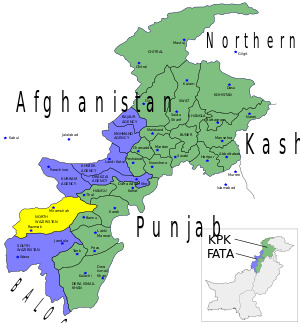
Geographically, the whole of Waziristan is a single unit. However, for administrative convenience it has been split into two agencies: North and South Waziristan. The area has been described as a land of high and difficult hills with deep and rugged defiles. The mountains of North Waziristan are geographically separate from the larger mountain systems of Koh-e-Sufaid in the north and Sulaiman in the south. The Waziristan hills were subject to igneous activity during the late Cretaceous period. The highly mineralised zone of Razmak is connected with it. The mountains and hills form a rampart between Pakistan and Afghanistan. The average height of the Waziristan hills is 1,500–2,500 metres (4,900–8,200 ft) above sea level. The important ranges in the Waziristan hills are Derwesta, Laran, Vizhda, Ingame, Shoidar (the highest peak Shuiar Sar of NWA is part of this range; visible from Cadet College Razmak also), Shawal, Eblunkai, Alexandra, Muzdak and Zakha.[بحاجة لمصدر]
The Tochi River flowing through the agency has formed the Tochi Pass, through which armies, people and cultures have moved in and out of this region. The Tochi Pass connects Ghazni, Afghanistan with Bannu, Pakistan. The Tochi River has carved a large and important valley which is bounded by hills and mountains on all sides except the eastern side. It is about 100 kilometres (60 mi) in length and opens up into the Indus Valley near Bannu. The Tochi valley is fertile and cultivable. Ketu and Kurram are the two minor rivers which flow in the northern part of the agency.
الأنهار
There are five notable rivers: Tochi, Kaitu, Kurram, Khaisor, and Shaktue. Some notable streams are Kishi Aigad, Chashma Aigad, Saidgi Algad, Kanungo Aigad, Sagga Aigad, Tauda China Algad, Damoma Algad, Tarkhobi Algad, Suedar Aigad.[بحاجة لمصدر]
الإدارة
North Waziristan District is currently subdivided into nine tehsils.[11][12][13]
- Datta Khel Tehsil (أردو: تحصیل دتا خيل)(Pashto: دته خېل تحصیل)
- Dossali Tehsil (أردو: تحصیل دوسالی)(Pashto: دوسالي تحصیل)
- Gharyum Tehsil (أردو: تحصیل گھریوم)(Pashto: ګریوم تحصیل)
- Ghulam Khan Tehsil (أردو: تحصیل غلام خان)(Pashto: غلام خان تحصیل)
- Mir Ali Tehsil (أردو: تحصیل میر علی)(Pashto: مير علي تحصیل)
- Miran Shah Tehsil (أردو: تحصیل میران شاہ)(Pashto: میران شاه تحصیل)
- Razmak Tehsil (أردو: تحصیل رزمک)(Pashto: رزمک تحصیل)
- Shawal Tehsil (أردو: تحصیل شوال)(Pashto: شاول تحصیل)
- Shewa Tehsil (أردو: تحصیل شیوہ)(Pashto: شېوا تحصیل)
- Spinwam Tehsil (أردو: تحصیل سپین وام)(Pashto: سپین وام تحصیل)
. . . . . . . . . . . . . . . . . . . . . . . . . . . . . . . . . . . . . . . . . . . . . . . . . . . . . . . . . . . . . . . . . . . . . . . . . . . . . . . . . . . . . . . . . . . . . . . . . . . . . . . . . . . . . . . . . . . . . . . . . . . . . . . . . . . . . . . . . . . . . . . . . . . . . . . . . . . . . . . . . . . . . . . .
Provincial Assembly
| Member of Provincial Assembly | Party Affiliation | Constituency | Year |
|---|---|---|---|
| Muhammad Iqbal Khan | Pakistan Tehreek-e-Insaf | PK-111 North Waziristan-I | 2018 |
| Mir Kalam Wazir | Independent | PK-112 North Waziristan-II |
المناخ
The climate of the area is cold in winter and warm in summer. The Summer season starts in May and continues until September. June is generally the warmest month. The mean maximum and minimum temperatures during the month of June are 31 and 18 degrees Celsius, respectively. Winter starts in October and continues until April. December, January, and February are the cold months. The mean maximum and minimum temperatures during the month of January are 10 and −2 degrees Celsius, respectively. Rainfall is low except in the Razmak area where the rainfall is slightly higher.
آثار
In 1966, Ahmad Hasan Dani located Buddhist sites from the area:
Coins of the Parthian and Kusana rulers have been found previously in the Shertala plain. Some archeological finds were reported by Sir Aurel Stein. In fact we also located during our visit a Buddhist Stupa site not far from Spinwam. But nothing definite is known about the early history of this region.
السكان
| Year | Pop. | ±% p.a. |
|---|---|---|
| 1951 | 128٬235 | — |
| 1961 | 159٬470 | +2.20% |
| 1972 | 250٬663 | +4.20% |
| 1981 | 238٬910 | −0.53% |
| 1998 | 361٬246 | +2.46% |
| 2017 | 540٬546 | +2.14% |
| Sources:[14] | ||
At the time of the 2017 census the district had 58,880 households and a population of 540,546. North Waziristan had a sex ratio of 946 females per 1000 males and a literacy rate of 36.61% – 59.99% for males and 12.49% for females. 4,364 (0.81%) lived in urban areas. 36.90% of the population were under 10 years of age. 842 (0.16%) people in the district were from religious minorities, predominantly Christian.[2]
At the time of the 2017 census, 97.57% of the population spoke Pashto and 1.08% Punjabi as their first language.[2]
الجماعات العرقية والقبائل
The chief tribes in North Waziristan are the Utmanzai, Wazirs and Dawars. There are small tribes, like the Gurbaz, Kharsins, Saidgis and Malakshis, Mahsuds, Banuchi and Bangashs. These tribes, except the Saidgis, are Pakhtuns. According to the tribal annals, they are descendants of Karlan, who are descended from Qais Abdur Rashid. Some historians believe that they are ethnically Semites. The traditions of the tribesmen, however, indicate that they are descendants of Karlan and are, therefore, generally accepted as being a tribe of Karlanri Pakhtuns. The Saidgis are the descendants of a Syed who accompanied the founder of the Wazir tribe.
The Wazirs dominate the hilly tracts: Khaisora, Sherathala Plain, Spinwam Mirali, Shewa, Kaitu Valley, Razmak, lower stretches of the Kurram River, upper parts of Tochi Valley beyond Kharakamar and alongside the Tochi Valley such as Anghar kalay, Spalga, Mir Khon Khel. They are divided into three main sections: Ibrahim Khel, Wali Khel, and Mohmit Khel. These sections are further divided into several sub-sections.
The Dawars are divided into two main sections: Tor Gund and Spin Gund. The inhabitants of village Tappi, village Miramshah, and Issuri Haidar Khel are Tor Gund and the remaining are Spin Gund. In the time of Ahmad Shah Durrani, the total number of Dawars was 12,000 (3,000 Tor Gund 9,000 Spin Gund), and Waziris were 60,000. The traditional jirga of Spin Gund are still called "lazariza" (the meeting of all the 9,000 Spin Gund). Those living under the administrative control of Miramshah tehsil are known as "Upper Dawars". Those living under the administrative control of Mirali tehsil are known as Lower Dawars. They have settled in the fertile Tochi valley, mostly on the left bank of the Tochi River, from Khajuri to Kharkamar. They are more educated as compared to Wazirs because most of the educational institutions are in the Dawar area.
The Kharsins are affiliated with Bora Khel and Madda Khel Wazirs. They live near the Durand Line to the northwest of the agency flanked by Madda Khel Wazirs and Saidgis. Mahsuds are the cousins of Wazirs; both have common ancestor: Wazirs. A section of Mahsuds called Bahlol Zai Malakshai occupy a small portion of Razmak surrounded by Bora Khel and Tori Khel Wazirs. The Saidgis occupy Zoi valley, Shawal. Dawegar and Dande plain near the Durand Line. The Kabulkhel contains Miami, Malakshahis, Pipali'Saifali are located in Shewa tehsil. Kabulkhel has two regions in Waziristan: Shawal and Shawa. They migrate to Shawal in summer.
الملبس والزينة
The common dress of tribesmen consists of shirt, trousers, waist-coat, sheet of cloth, turban, and Chappal. A Wazir woman wears a sleeved blouse or petticoat and a long heavy shirt, locally famous as Staar Khat with trousers. She covers her head and body with a sheet of cloth. A married woman wears coloured trousers while an unmarried woman wears simple trousers. For festivals and marriages, Wazir women put on colourful and ornamented blouses and multi-coloured frocks sometimes made of 40 metres (130 ft) cloths. To further adorn themselves, the women put on rectangular pieces of silver and gold that hang on their forehead and side-ways down to ear. While the dress of Dawars are almost the same as the Wazirs, although there are some differences due to regional, and climate variations. Dawar wear almost all kind of dresses usually used throughout Pakistan.
المأكل
The staple food of the tribesman is wheat or maize bread. Milk is consumed in its various forms. Roasted meat larmin is relished. The people of Waziristan generally like a fried goat dish called pulawo, served in hilly areas.[بحاجة لمصدر]
المسكن
The Dawars live in houses close together in a compact area. Large joint Waziri families live either in one house called ket or kot or in houses adjacent to one another, but separated from the houses of the other families. A walled enclosure of mud or mud and stones three to five metres (16.4 ft) high is called a kot. Most kots have a fort-like structure, with a tower in the centre, which is used as a strategic point for fighting with the enemy when hostilities break out. Every section in a village has a Masjid and a common sitting place. One or more households have a private guest house hujra attached to the house. In a house, there may be one or several rooms. Wazirs people mostly live near mountainous areas and they have a generally different lifestyle from the Dawar tribes, who live near rivers and on plains.
. . . . . . . . . . . . . . . . . . . . . . . . . . . . . . . . . . . . . . . . . . . . . . . . . . . . . . . . . . . . . . . . . . . . . . . . . . . . . . . . . . . . . . . . . . . . . . . . . . . . . . . . . . . . . . . . . . . . . . . . . . . . . . . . . . . . . . . . . . . . . . . . . . . . . . . . . . . . . . . . . . . . . . . .
الاقتصاد
Due to the rugged nature of the terrain and their lack of education, many inhabitants believe they must depend upon government services. Many emigrate abroad to earn livelihoods. Local people have also invested in transportation-related businesses. Wazir tribes generally run businesses, while Dawar tribes are more heavily employed through government services, particularly in education sector and civil services.[بحاجة لمصدر]
التعدين
The following minerals have been found in the area:
- Copper associated with volcanics at Boya[15] and Manzarkhel Spinkamar (east of Shora-Algad)
- Manganese associated with cherts
- Chromite associated with serpentinites. There are only two mining sites of chromite: at Syed Abad (Mohammad Khel); and Saidgi.
- Gold and diamond mines in Muhammad Khel
- In some hills, ordinary stones are mined for construction of buildings, etc.
Nowadays chromite and copper mining have occurred at Razmak Malakan village.
أشخاص بارزون
- Arsala Khan, Pakistani politician
- Mohammed Wasim, Pakistani cricketer
- Mohsin Dawar, Pakistani politician
- Faqir of Ipi, Pashtun Freedom Fighter
Places of interest
Miran Shah is the headquarters of North Waziristan District, It is connected with Bannu and other important places in the district by metalled roads. This town houses the offices of all government departments in the agency and also serves as a market centre for people of the area.
Razmak and Shawaal Valleys are both summer resorts for the local Waziristanis and beautiful tourist spots for tourists, thousands of tourists visit here annually.
Razmak Cadet College is one of the most famous and historical educational institutions of the country, and students from all corners of the country come to study here.[16]
Administrative setup
The district is under the general charge of a Deputy Commissioner who administers civil, criminal and revenue cases in accordance with Frontier Crimes Regulation and Customary Law. The North Waziristan District consists of three sub-divisions and nine Tehsils. The Miramshah sub-division comprises the Miramshah, Ghulam Khan, and Datta Khel tehsils. The Mirali sub-division contains the Mirali, Spinwam, and Shewa tehsils. The Razmak sub-division consists of the Razmak, Dossali, and Garyum tehsils. Each of the sub-divisions is headed by an Assistant Commissioner. The Deputy commissioner is assisted by three Assistant Commissioners in criminal cases and other official work including matters maintaining law and order in the agency. Assistant commissioners assist the Deputy commissioner in tackling problems of the agency. They perform their duties like a Liaison Officer between the Deputy commissioner t and the tribes. They also decide cases of minor criminal nature and civil suits.
A new post of Additional Deputy commissioner has been established who looks after the developmental sector of the whole agency. The need was felt for reason of high level intervention in developmental sector by both governmental and non-governmental organizations. In addition to these duties the Additional Political Agent acts as Political Agent in his absence. Furthermore, all the Line Directorates work under supervision of Additional Political Agent.
Political Tehsildars and Political Naib- Tehsildars are in charge of Tehsils and their main duty is to control the tribes and maintain law and order within their own areas. They are answerable to the Deputy Commissioner through the Assistant Commissioner. They deal with all cases occurring in the protected area of their respective Tehsils. Land revenue administration in some parts of the agency is carried on exactly on the same lines as in the settled districts of Pakistan. The Frontier Crimes Regulation is applicable in this area. Cases occurring in the unprotected area are decided by the tribes themselves through their elders who are known as Maliks and Motabars. The Maliki system introduced by British government was the same in North Waziristan district as functioning in other FATA. Maliks use to work like a medium between administration and the Qaum or tribe. A Maliki is hereditary and devolves on the son and his son so on and so both for which regular benefits and subsidies are sanctioned from time to time. Lungi system known as Sufaid Resh is slightly lower form of Maliki. In North Waziristan Agency there are 1,620 Maliks and Lungi holders.
إستراتيجية پاكستان لوزيرستان الجديدة
أحداث 2008
في أوائل نوفمبر 2008 قتل أربعة أشخاص على الأقل في قرية بشمال وزيرستان القبلية جراء صاروخ أطلقته ما يشتبه بأنها طائرة أمركية بدون طيار ، بينما أثنت وزارة الدفاع الأميركية على باكستان "لتصعيدها العمليات العسكرية" ضد المسلحين.
فقد ذكر مراسل لوكالة رويتزر أن الطائرة استهدفت قرية بالقرب من بلدة ميرانشاه الرئيسية في وزيرستان التي أسس فيها جلال الدين حقاني أحد قادة طالبان والصديق القديم لزعيم تنظيم القاعدة أسامة بن لادن مدرسة دينية يقيم فيها أفراد أسرته.
ويذكر أن القوات الأميركية نفذت حوالي 12 ضربة صاروخية وغارة للقوات الخاصة في المناطق القبلية الباكستانية منذ بداية سبتمبر 2008 قتل فيها عدد كبير من المسلحين، إلا أنه لم ترد تقارير حتى الآن عن وفاة أحد من القياديين البارزين في تنظيم القاعدة أو حركة طالبان.
وذكر مسؤول أمني أن الجيش الباكستاني شن لاحقاً هجوماً مضاداً على المنطقة حيث قتل خمسة مسلحين إضافة إلى من يُعتقد أنه انتحاري حيث انفجرت مركبته بعد تعرضها لإطلاق نار. [17]
انظر أيضا
- أضلع خيبر پختونخوا
- ميران شاه
- ضلع بنو
- ضلع جنوب وزيرستان
- قسم بنو
- وزيرستان
- جنوب وزيرستان
- الإمارة الإسلامية في وزيرستان
- المناطق القبلية في باكستان
المصادر
- ^ "District North Waziristan". Department of Local Government, Government of Khyber Pakhtunkhwa. Retrieved 11 February 2022.
- ^ أ ب ت "District Wise Results / Tables (Census - 2017)". www.pbscensus.gov.pk. Pakistan Bureau of Statistics.
- ^ "President signs Fata-KP merger bill into law". The Nation (in الإنجليزية الأمريكية). 2018-06-01. Retrieved 2018-07-06.
- ^ Wasim, Amir (2018-05-24). "National Assembly green-lights Fata-KP merger by passing 'historic' bill". Dawn (in الإنجليزية). Retrieved 2022-07-24.
- ^ Sirmed, Marvi (29 May 2018). "For FATA residents, the good news may be short-lived – Daily Times". Daily Times. Retrieved 30 May 2018.
- ^ "Assessment Report: North Waziristan Agency IDP's - Pakistan | ReliefWeb". reliefweb.int (in الإنجليزية). Retrieved 2022-07-24.
- ^ "DISTRICT AND TEHSIL LEVEL POPULATION SUMMARY WITH REGION BREAKUP – North Waziristan" (PDF). pbscensus.gov.pk. Archived from the original (PDF) on 26 March 2018. Retrieved 2018-07-06.
- ^ "Tribe: Ahmadzai Wazir" (PDF). Naval Postgraduate School.
{{cite journal}}: Cite journal requires|journal=(help) - ^ Sherazi, Zahir Shah (2014-07-08). "North Waziristan IDPs figure reaches 800,000". Dawn (in الإنجليزية). Retrieved 2022-07-24.
- ^ "Air raids flatten 5 militant hideouts". The Express Tribune. 14 July 2014. Archived from the original on 15 July 2014. Retrieved 14 July 2014.
- ^ "DISTRICT AND TEHSIL LEVEL POPULATION SUMMARY WITH REGION BREAKUP [PDF]" (PDF). pbscensus.gov.pk. 2018-01-03. Archived from the original (PDF) on 26 March 2018. Retrieved 2018-03-25.
- ^ "District North Waziristan". Local Government, Elections and Rural Development Department (in الإنجليزية الأمريكية). Retrieved 2022-07-24.
- ^ "Assessment Report: North Waziristan Agency IDP's - Pakistan | ReliefWeb". reliefweb.int (in الإنجليزية). Retrieved 2022-07-24.
- ^ "Population by administrative units 1951-1998" (PDF). Pakistan Bureau of Statistics.
- ^ Nawazkahn, M. "PAKISTAN MINERAL DEVELOPMENT CORPORATION-FATA-DC PESHAWAR". Geological Report of Shinkai Copper Mineralization North Waziristan Agency. Retrieved 19 October 2010.
- ^ Yusufzai, Rahimullah. "24 FC soldiers die in N Waziristan suicide bombing". The Indonesian Embassy, Islamabad Pakistan. Retrieved 19 October 2010.
- ^ الجزيرة نت
قالب:Districts of Khyber Pakhtunkhwa خطأ لوا في وحدة:Authority_control على السطر 278: attempt to call field '_showMessage' (a nil value).
- Pages using gadget WikiMiniAtlas
- CS1 الإنجليزية الأمريكية-language sources (en-us)
- Short description is different from Wikidata
- Articles containing أردو-language text
- Articles containing Pashto-language text
- Coordinates on Wikidata
- Pages using Lang-xx templates
- Articles with unsourced statements from November 2010
- Articles with unsourced statements from August 2021
- وزيرستان
- أضلع خيبر پختونخوا
- شلع شمال وزيرستان
